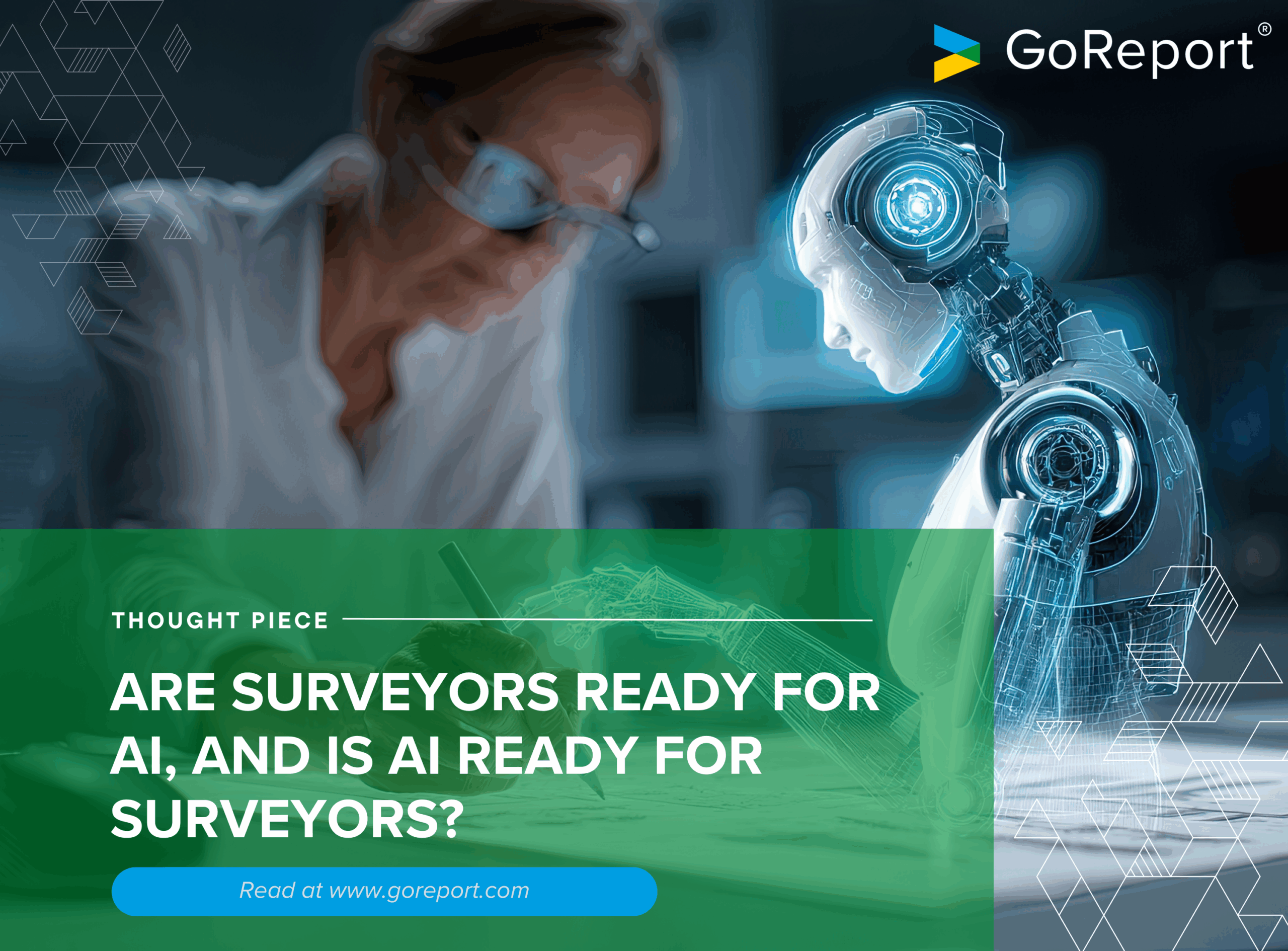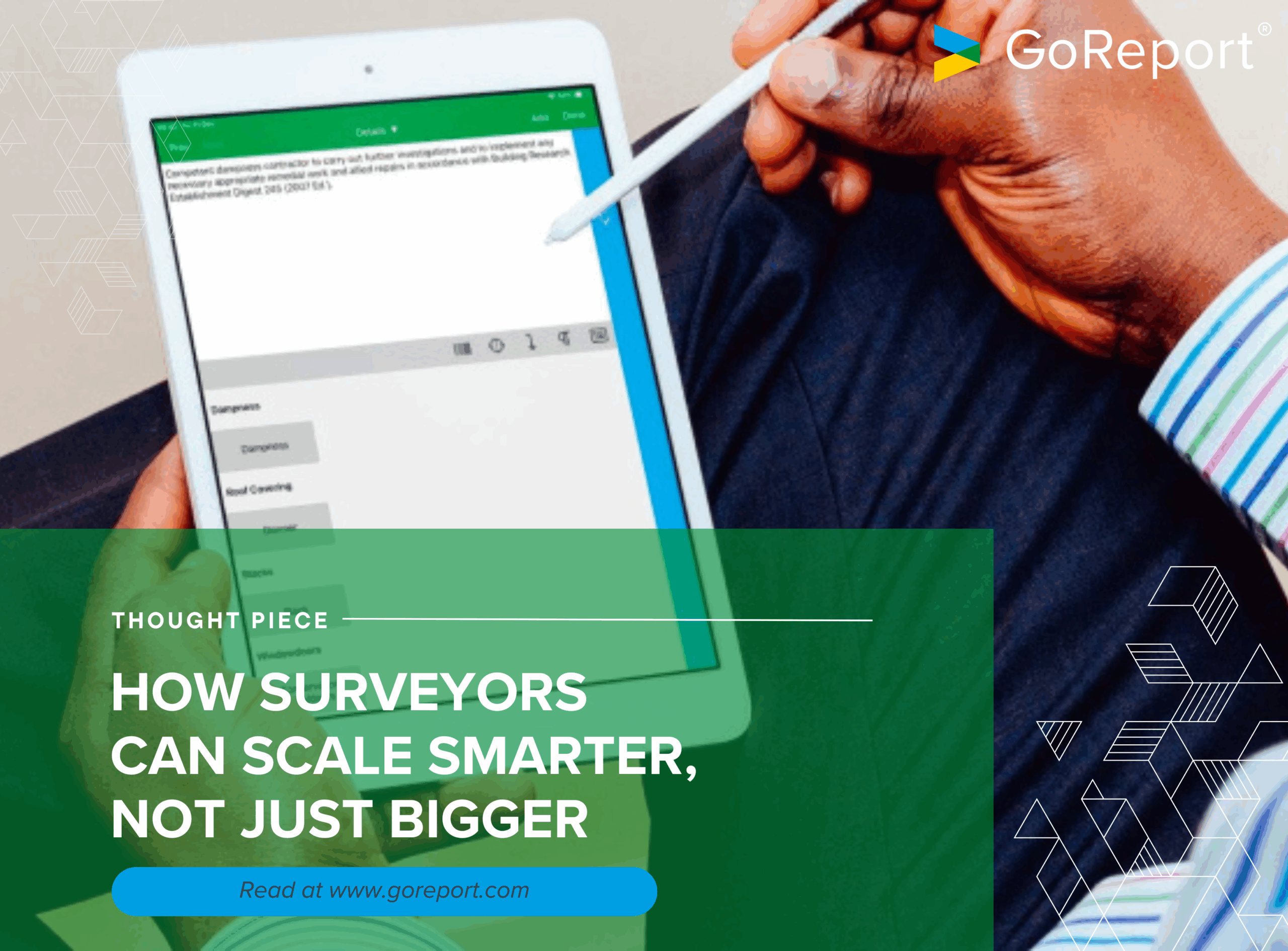Are Surveyors Ready for AI, and Is AI Ready for Surveyors?

The property industry is no stranger to big promises. Over the past decade, surveyors have watched technology after technology claim it will “revolutionise” the profession, from 3D modelling to digital data capture. Now, AI has entered the conversation with the same energy.
Amid the hype lies a practical question worth asking: is AI genuinely ready for the realities of surveying? Or, just as importantly, are surveyors ready to integrate AI responsibly and intelligently into their practice?
Surveyors operate within an exacting triangle of accuracy, speed, and cost. Clients demand rapid turnarounds; insurers expect clear evidence; regulators insist on traceability. AI offers an enticing promise to tip that balance toward efficiency – but only if its outputs are robust, auditable, and trustworthy.
This article explores how AI can genuinely support the surveying profession and where caution, structure, and professional judgement must remain at the core.
When AI feels useful (and when it doesn’t)
In its early applications, AI has proven capable of supporting administrative, linguistic, and descriptive tasks far more reliably than interpretive ones. Many surveyors trialling new tools have seen the pattern: AI handles grammar, structure, and straightforward contextual language with impressive fluency, yet struggles when asked to apply technical judgement or diagnose complex conditions.
AI performs most reliably within well-defined zones of certainty, where:
- Inputs follow a consistent structure, such as standard forms or templates
- Outputs can be objectively verified, such as grammar or layout corrections
- Errors carry limited risk, for example in draft text rather than final reports
Within these zones, AI can be used effectively to:
- Run grammar and spell checks on free-text sections
- Flag contradictions or inconsistencies across the document
- Expand shorthand site notes into clear, professional language
- Add captions to photographs, helping to describe context or highlight key features for easier referencing
In fact, GoReport has begun integrating these capabilities directly into its platform, combining efficiency with the precision required for professional reporting. Such use cases free surveyors from repetitive, lower-value tasks and help maintain clarity across reports.
However, there remains a clear boundary between describing what’s visible and diagnosing what it means. AI can competently generate an image caption noting a “hairline crack on an internal wall”, but determining why it has occurred – whether that be thermal movement, settlement, or structural stress – still depends on professional expertise.
AI can assist by providing contextual references or suggesting possible causes, helping surveyors to assess a broader range of possibilities. Yet the final interpretation, and the decision that follows, must always rest with the surveyor’s judgement and accountability.
The standards catching up to practice
Regulation is moving quickly to catch up with technology.
In September 2025, RICS introduced a global standard for responsible use of AI in surveying, coming into force in March 2026. The standard is not optional guidance; it establishes firm expectations for professional accountability in AI-assisted work.
Key requirements include:
- Documenting governance, risk assessments, and decision logs
- Maintaining professional scepticism and accountability for all AI outputs
- Transparent client disclosure of AI use in reports
- Ensuring any AI system used meets ethical, legal, and data quality standards
The result is a new layer of professional due diligence. Surveyors will need to provide evidence of how AI is tested, validated, and governed. As oversight deepens, practices that treat AI as a tick box or a marketing gimmick will find themselves exposed.
Where AI can make a measurable difference
AI is not a replacement for surveying expertise, but it can meaningfully reduce administrative friction and improve quality control. There are three domains where AI already provides clear benefits when applied thoughtfully.
1. Text and language accuracy
AI tools excel at improving written clarity and consistency.
They can:
- Correct grammar, punctuation, and style
- Expand shorthand or abbreviations into clear prose
- Detect contradictions such as “no damp” versus “evidence of moisture”
- Auto-generate text sections from structured inputs, such as room measurements
Used as a first-pass layer, these functions streamline workflows while preserving the surveyor’s control and voice.
2. Template consistency and pattern recognition
AI can also act as a digital proofreader at scale, identifying issues that are difficult to spot manually.
It can:
- Check whether all required clauses and sections are present
- Flag anomalies against established patterns
- Recommend relevant standards or clauses based on context
- Highlight statistical outliers across a portfolio of reports
These capabilities strengthen internal quality assurance processes and reduce the likelihood of small but costly oversights.
3. Intelligent field support
An emerging area of promise is the use of surveying-focused AI assistants – tools trained on industry standards and in-house knowledge. They can answer quick technical questions, provide reference suggestions, or clarify procedural points while on site.
When built responsibly, such assistants cite their sources, indicate confidence levels, and allow the surveyor to override responses. This helps professionals maintain control of the decision-making process while still benefiting from real-time support.
GoReport’s latest AI features reflect this principle, supporting productivity without eroding professional autonomy. They include a grammar and spelling checker, shorthand note expansion, and a surveying-specific AI assistant tailored to the language of surveying and property reporting.
The real risks and how to stay protected
While the potential is clear, so are the risks. AI introduces new forms of exposure that surveyors cannot afford to overlook. This rings particularly true when utilising the likes of ChatGPT, which isn’t trained to be surveying specific. This is why GoReport ensures all of its AI tools have been fine-tuned to serve surveyors and stay compliant.
Key risks include:
- Hallucination – AI generating plausible but incorrect statements
- Bias and data gaps – Poorly trained models performing inconsistently across property types or regions
- Accountability ambiguity – Unclear responsibility if AI-generated content is wrong
- Data integrity – Issues with how photos, notes, or records are labelled and stored
To mitigate these, surveyors can adopt several practical safeguards:
- Maintain human-in-the-loop governance, with mandatory review of all AI outputs
- Record AI-related decisions and keep version control logs
- Test AI performance against known, validated datasets
- Use tools with clear explainability, those that show why a suggestion was made
- Provide team training focused on understanding limitations and proper use
The balance to strike is one of augmented intelligence, not artificial independence.
A stepwise approach to integrating AI safely
Bringing AI into a surveying practice doesn’t need to be complicated. A steady, practical approach helps you get the most from the technology while keeping standards high.
- Start small, with simple tasks – Begin with low-risk uses such as language or formatting checks. Choose surveyor-specific tools rather than generic AI platforms, as these are designed around industry needs and reporting standards.
- Review suggestions regularly – Keep an eye on AI-generated content to make sure it fits your tone, terminology, and professional judgement. Noting any recurring issues helps improve how the tool is used.
- Test before you rely on it – Try AI for higher-value tasks, like draft defect summaries or data categorisation, but always review results before including them in client reports.
- Train your team – Make sure everyone understands how to check and refine AI outputs so that accuracy and consistency are maintained across reports.
- Set clear guidance – Have a simple policy that outlines when and how AI should be used, ensuring consistency and accountability.
By taking small, measured steps and using tools designed for surveyors, you can make AI part of your workflow with confidence and ease.
Moving toward smarter surveying
AI’s role in surveying should not be defined by automation alone. Its true potential lies in helping professionals refocus attention where it matters most: expert interpretation, critical thinking, and client communication.
Used thoughtfully, AI can reduce the friction of administration and improve report consistency, but human judgement will always remain the foundation of the profession.
GoReport’s aim is to support that balance by developing technology that empowers surveyors to work smarter, not to replace their expertise. The new AI assistant, grammar and spelling checker, and shorthand expansion tools are built to serve that principle: precision supported by technology, guided by professional intelligence.
Surveying has never stood still. The question now is not whether AI will change the profession but whether the profession will shape how AI is used.
Curious how these tools can work in practice? Explore a free GoReport demo to see how AI assistance can streamline your reporting while keeping your expertise firmly in control.







